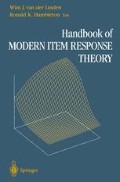Abstract
The extension of item response theory to data from more than one group of persons offers a unified approach to such problems as differential item functioning, item parameter drift, nonequivalent groups equating, vertical equating, two-stage testing, and matrix-sampled educational assessment. The common element in these problems is the existence of persons from different populations responding to the same test or to tests containing common items. In differential item functioning, the populations typically correspond to sex or demographic groups; in item parameter drift, to annual cohorts of students; in vertical equating, to children grouped by age or grade; in nonequivalent groups equating, to normative samples from different places or times; in two-stage testing, to examinees classified by levels of performance on a pretest; and in matrix-sampled educational assessment, to students from different schools or programs administered matrix-sampled assessment instruments. In all these settings, the objective of the multiplegroup analysis is to estimate jointly the item parameters and the latent distribution of a common attribute or ability of the persons in each of the populations.
Access this chapter
Tax calculation will be finalised at checkout
Purchases are for personal use only
Preview
Unable to display preview. Download preview PDF.
References
Andersen, E.B. and Madsen, M. (1977). Estimating the parameters of a latent population distribution. Psychometrika 42, 357–374.
Bock, R.D. ( 1985 reprint). Multivariate Statistical Methods in Behavioral Research. Chicago: Scientific Software International.
Bock, R.D. (1989). Measurement of human variation: A two-stage model. In R.D. Bock (ed.), Multilevel Analysis of Educational Data (pp. 319–342 ). New York: Academic Press.
Bock, R.D. and Aitkin, M. (1981). Marginal maximum likelihood estimation of item parameters: Application of an EM algorithm. Psychometrika 46, 443–445.
Bock, R.D. and Kolakowski, D. (1973). Further evidence of sex-linked major-gene influence on human spatial visualizing ability. American Journal of Human Genetics 25, 1–14.
Bock, R.D. and Lieberman, M. (1970). Fitting a response model for n dichotomously scored items. Psychometrika 35, 179–197.
Bock, R.D. and Mislevy, R.J. (1981). An item response model for matrix-sampling data: The California grade-three assessment. New Directions for Testing and Measurement 10, 65–90.
Bock, R.D. and Zimowski, M. (1989). Duplex Design: Giving Students A Stake in Educational Assessment. Chicago: Methodology Research Center, NORC.
Day, N.E. (1969). Estimating the components of a mixture of normal distributions. Biometrika 56, 463–473.
de Leeuw, J. and Verhelst, N. (1986). Maximum likelihood estimation in generalized Rasch models. Journal of Educational Statistics 11, 193–196.
Dempster, A.P., Rubin, D.B., and Tsutakawa, R.K. (1981). Estimation in covariance component models. Journal of American Statistical Association 76, 341–353.
Dorus, E., Cox, N.J., Gibbons, R.D., Shaughnessy, R., Pandey, G.N., and Cloninger, R.C. (1983). Lithium ion transport and affective disorders within families of bipolar patients. Archives of General Psychiatry 401, 945–552.
Gasser, T., Müller, H.-G., and Mammitzsch, V. (1985). Kernels for non-parametric curve estimation. Journal of the Royal Statistical Society, Series B 47, 238–252.
Kiefer, J. and Wolfowitz, J. (1956). Consistency of the maximum likelihood estimator in the presence of infinitely many incidental parameters. Annals of Mathematical Statistics 27, 887–906.
Kolakowski, D. and Bock, R.D. (1982). A multivariate generalization of probit analysis. Biometrics 37, 541–551.
Lindsay, B., Clogg, C.C., and Grego, J. (1991). Semiparametric estimation in the Rasch model and related exponential response models, including a simple latent class model for item analysis. Journal of the American Statistical Association 86, 96–107.
Lord, F.M. and Novick, M.R. (1968). Statistical Theories of Mental Test Scores (with Contributions by A. Birnbaum). Reading, MA: Addison-Wesley.
Mislevy, R.J. (1983). Item response models for grouped data. Journal of Educational Statistics 8, 271–288.
Mislevy, R.J. (1984). Estimating latent distributions. Psychometrika 49, 359–381.
Mislevy, R.J. and Bock, R.D. (1996). BILOG 3: Item Analysis and Test Scoring with Binary Logistic Models. Chicago: Scientific Software International.
Muraki, E. and Bock, R.D. (1991). PARSCALE: Parametric Scaling of Rating Data. Chicago: Scientific Software International.
Reiser, M.R. (1983). An item response model for demographic effects. Journal of Educational Statistics 8 (3), 165–186.
Sanathanan, L. and Blumenthal, N. (1978). The logistic model and estimation of latent structure. Journal of the American Statistical Association 73, 794–798.
Sirotnik, K. and Wellington, R. (1977). Incidence sampling: An integrated theory for “matrix-sampling ” Journal of Educational Measurement 14, 343–399.
Zimowski, M.F., Muraki, E., Mislevy, R.J., and Bock, R.D. (1996). BILOGMG: Multiple-Group IRT Analysis and Test Maintenance for Binary Items. Chicago: IL: Scientific Software International.
Editor information
Editors and Affiliations
Rights and permissions
Copyright information
© 1997 Springer Science+Business Media New York
About this chapter
Cite this chapter
Bock, R.D., Zimowski, M.F. (1997). Multiple Group IRT. In: van der Linden, W.J., Hambleton, R.K. (eds) Handbook of Modern Item Response Theory. Springer, New York, NY. https://doi.org/10.1007/978-1-4757-2691-6_25
Download citation
DOI: https://doi.org/10.1007/978-1-4757-2691-6_25
Publisher Name: Springer, New York, NY
Print ISBN: 978-1-4419-2849-8
Online ISBN: 978-1-4757-2691-6
eBook Packages: Springer Book Archive

